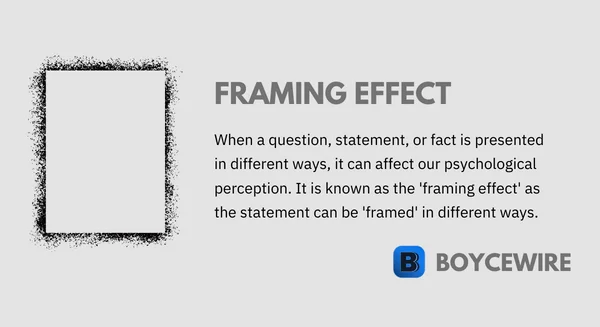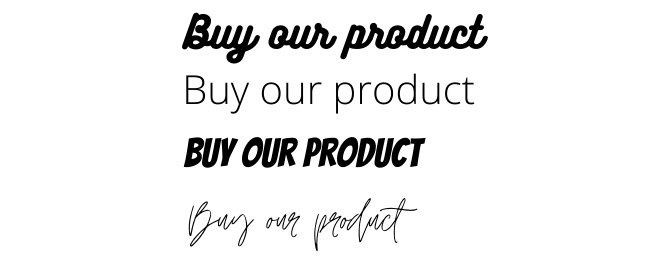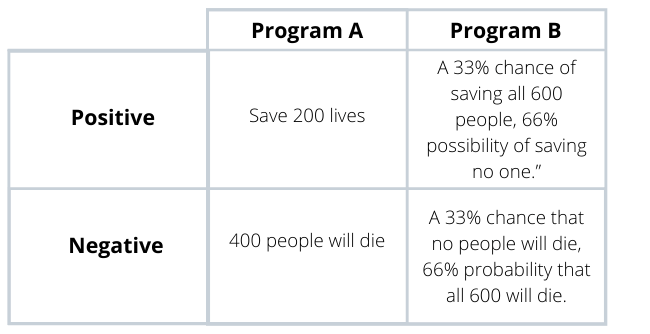Framing Effect: What it is, Types & Examples

What is the Framing Effect
The framing effect is a cognitive bias that impacts our decision making when said in different ways. In other words, we are influenced by how the same fact or question is presented.
For example, take two yogurt pots. One says “10 percent fat” and another says “90 percent fat free”. The framing effect will lead to us picking the second option, as it seems like the second is the healthier option.
Key Points
- The Framing effect is where we are presented two or more options, but the outcome is the same.
- Options are worded differently (framed) so that they appeal to our biases.
- We tend to value options that are framed positively.
- We tend to choose options that have higher numbers, as our bias believes that higher is better.
Prospect theory states that individuals are more sensitive to losses than gains, so we tend to become risk-averse. When presented with a 50-50 chance of gaining or losing an equal amount, we tend to avoid such a choice. This is because the fear of loss is greater than the happiness of gaining.
The framing effect is specifically when the outcome between the two options is the same. In other words, it doesn’t matter which is chosen, the result will be the same. However, when the options are framed differently, they result in us choosing the one that is favorably framed.
So when it comes to the framing effect, we tend to choose the option that comes across as a gain as opposed to a loss. For example, option one offers a $50 gain. Option two offers a $100, but a $50 loss. Now the two options lead to a $50 gain, but the first option is favored because a loss is not presented.
Types of Framing Effect
There are four main types of framing. The first is the visual frame which includes colour, font-size, and imagery. We then have auditory frames that can be framed in different tones and pitches.
There are also value frames, which assign numerical figures, percentages, and other such values. Then the final frame is positive and negative frames. Let us look at them below.
1. Auditory Frame
The auditory frame is relatively straight forward. When we are given two options, we can be significantly influenced by how they are asked. Are they shouted, with a deep and aggressive tone?
These frames tend to be a bit more nuanced, but we can look at both ends of the spectrum to make the point. For instance, a car salesman says to us in a shy and naïve way ‘how ccc-an I help you today?”. They don’t sound confident, so they are unlikely to get our attention or sale.
By contrast, we have a confident, well-spoken car salesman who asks us “How can I help you today?” The same words, just spoken with more confidence and a more suitable inflection.
Voice inflection can be crucially important. In fact, it is more important than what is actually said. At the same time, the speed and volume are also important when framing.
Asking a question quickly can come across more aggressively than when asked slowly. However, it may be more useful when stating facts. We then have volume. Parents who are telling their kids off will raise their voices to let them know they’re serious. By contrast, a softer tone is gentler and loving.
2. Visual Frames
Visual frames can cover factors such as color, imagery, font-size, font-style, or even body language. Colour, for instance, can be rather influential, with each promoting a slightly different characteristic. For example, pink has a more feminine feel, so it’s probably not the best color to promote men’s clothing.
Colour
Looking at the picture below, we have two images of the same picture. One with a pink background and the other with a more neutral grey background. Now the pink one is potentially more eye-catching but won’t appeal to the majority of men. It’s the same image but framed differently.

Other colors work to create different qualities and unique perspectives on the product or service being sold. In turn, these can influence our decision making. Take cars for example. Most of those on the average forecourt will be grey, white, black, or some shade of such. The reason? Well, first of all, they are the most popular colors and second of all, they fit in with the crowd.
Often, we like to conform to social norms. That means following what everyone else is doing, including getting a silver car. In addition, silver, white, and black are relatively neutral colors. They aren’t in your face or stand out like a sore thumb which is why they are so popular.
So when forecourts look at what cars to ‘frame’, they tend to use such neutral colors. It can have a significant effect on how we interpret the car and our feelings towards it. Having pink or yellow cars at the front is going to push a lot of customers away and reduce sales whilst a neutral color does the opposite.
Font-Size and Style
There is a whole science behind how fonts can make us feel. They can be framed in the same way but can trigger different responses just from the size or style alone. If we look at the example below, each is in a different font but with the same wording. The first and last aren’t very legible, so using such a font wouldn’t be very effective.
We also have the ‘small print’. Most of the time, we won’t bother reading it. Why? Because it’s so small that it’s difficult to read and we simply just miss it. If it was larger and more legible, perhaps more of us would read it. Yet, because of the way it’s framed, we don’t.
The reason is quite simple. If we don’t read the small print, we won’t realize what is covered by the warranty and what isn’t.

Body Language
Body language is perhaps one of the most under-rated framing factors. In fact, research by Dr. Mehrabian found that as much as 55 percent of communication can be attributed to body language.
Factors such as a smile, demeanour, facial expressions, and stance can all contribute to the framing of a question. For example, imagine going to a car salesman and them telling you they want $20,000 for the car whilst their arms are crossed.
Now imagine them asking whilst they are looking at the floor and with a hunched back. Hardly a positive sign even though the words may be the same.
If we now imagine them asking with a shoulder wide stance and their hands clasped together. These frames may not completely influence our decision as much as verbal, value, or positive and negative frames, but they can, in fact, contribute to our decision. For instance, we will be more likely to buy from a warm and friendly salesman compared to one that seems disinterested.
3. Value Frames
Quite simply, value frames are where psychological techniques are used to make us feel that we are getting a better deal or offer than we really are. For instance, higher values tend to make us believe that it means it’s a better deal. This is driven by the availability heuristic which tries to simplify the cognitive process by using easily available information in our brain.
Higher numbers tend to mean better value. A 90 percent discount is better than a 50 percent discount, right? That’s obvious, but when we play around with the framing, we can see the difference.
Let’s say Susan’s Laptop Shop is in the business of selling laptops. She has some high-quality Apple Mac’s in stock and has an offer on them, but is unsure how to word it.
The Macs are currently selling for $600. Susan needs to choose between the two options:
Option 1 – 20 percent off MacBook’s.
Option 2 – $120 off MacBook’s.

Most retailers will choose the second option. In fact, it is a commonly used strategy, known as ‘the rule of 100’. Quite simply, anything under $100 is more appealing as a percentage. So 10 percent off a $10 good is more appealing than $1 off.
By contrast, the opposite holds true for goods over $100. For instance, $50 off is generally more appealing than 10 percent off a $500 good.
We also have negative and positive value frames. For instance, Mr. Longley wants to start his own business. He is told that his business has a 90 percent chance of failing. By contrast, he has a 10 percent chance of success. Although it’s still a low percent, it is still framed in a more positive way. Therefore, it’s a better way to encourage Mr. Longley to start his business.
4. Positive and Negative Frames
When we talk about positive and negative frames we can look at the classic example of the glass half full, or is it half empty? Many marketers use such negative frames to get us to take action and buy their products.
You may recollect phrases such as ‘Don’t miss out’ or ‘Your last chance to save’. The frame is simple – make people feel like they are losing something. As stated in prospect theory, people tend to fear and take action to avoid losses more so than gains. So when we may lose out on a good deal, we are encouraged to take action.
Negative frames are effective in certain scenarios. They can create urgency among the customer and convert sales. Whilst positive frames can work better in convincing people. For instance, patients tend to be more receptive to surgery when there is a 90 percent chance of survival than a 10 percent chance of death.
Our fear of loss is strong, but we tend to seek out positivity. After all, nobody likes to hang around that one person who is bringing everyone down with negativity. It is for this reason that positive frames tend to be more effective on the whole.
What many advertisers do is combine both a negative and positive frame in one. For instance, ‘Sugar consumption means we lose our enamel’ (negative frame), ‘but you can replace this with Toothpaste ABC’ (positive frame). This is a classic marketing example. Create the problem (tooth decay) and then present the solution.
Framing Effect Experiment
In 1981, Tversky and Kahneman conducted an experiment with regards to the framing effect. They asked students from Stanford University and at the University of British Columbia who answered brief questionnaires in a classroom setting.
They were asked to imagine that the US is preparing for an Asian disease which is expected to kill 600 people. There are two programs that are presented to the students to deal with the problem.
If Program A is adopted, 200 people will be saved. If Program B is adopted, there is a 1/3 probability that 600 people will be saved, and 2/3 probability that no people will be saved. The two options can be categories as below.

You may have noticed that both programs will result in the same number of deaths, but are framed in different ways. The results concluded that 72 percent of participants chose Program A (positive framing), whilst 28 percent chose Program B (negative framing).
So even though the outcomes were the same, the vast majority of people chose the more positive option. Yet at the same time, it is not conclusive and only demonstrates the fact that our brains work differently from each other. Even though framing can be effective, it may not have the desired effect on a minority of the population.
Framing Effect Examples
The framing effect is a cognitive bias that influences our decision making based on how information is presented. It refers to the idea that we can change the way we respond to information by changing the way the information is framed or presented. Here are some examples:
Example #1 – Surgery
In a study, doctors were told about a surgical procedure that had a 90% survival rate in one group and a 10% mortality rate in another. Even though the statistics were the same, doctors were more likely to recommend the surgery when the survival rate was emphasized.
Positive Frame – You have a 90 percent chance of surviving the operation.
Negative Frame – You have a 10 percent chance of dying during the operation.
Example #2 – Medication
Doctors often have to present the benefits and side effects of a medication to a patient. Consider a medication that has a success rate of 70%. If the doctor frames this as “70% of patients have been successfully treated with this medication”, patients are likely to view the medication positively. However, if the doctor says “30% of patients do not respond to this medication”, even though it’s the same statistic, patients may view the medication negatively. This is an example of the framing effect.
Positive Frame – If you take this medication, you will have a 70% success rate.
Negative Frame – If you don’t take this medication, there is a 30% chance it may not succeed.

Example #3 – Negotiation
In a negotiation, the framing effect can be seen in how offers are presented. For example, if a seller is trying to sell a car, they might frame the price as “only $30 a day” rather than “$10,950 a year” or “$21,900 for two years.” This makes the cost seem more manageable, even though it’s the same amount.
Positive Frame – only $30 a day.
Negative Frame – $10,950 a year.

Example #4 – Sports
A coach may use the framing effect to motivate a team. For instance, instead of saying “we have lost 3 games out of 10”, the coach may say “we have won 7 games out of 10”. The choice of words can frame the situation in a more positive light, motivating the team to perform better.
Positive Frame – we have won 7 games out of 10.
Negative Frame – we have lost 3 games out of 10.

Example #5 – Politics
Politicians often employ the framing effect to sway public opinion. For example, a policy might be introduced that raises taxes. One side might frame it as a “Tax Burden Increase” which sounds negative, while the other side might refer to it as “Investing in Our Future”, which puts a positive spin on the same situation. The framing of the policy can significantly impact how it is received by the public.
Positive Frame – Investing in Our Future.
Negative Frame – Tax Burden Increase.

FAQs
One example of the framing effect is the packaging of meat. Studies have shown that 75% lean meat is usually preferred over 25% fat meat, even though they are the same, just framed differently. Part of the reason is purely the fact that it’s a higher number, so is therefore superior.
Framing effects occur because our brains tend to take shortcuts, otherwise known as heuristics. These shortcuts are usually helpful, but can lead us to bad decisions. In addition, we tend to favour positive messaging. For instance, ‘you have a 90 percent chance of surviving surgery’ is better received than ‘you have a 10 percent chance you may die’.
In economics, the framing effect can impact on consumer behaviour. When advertisements and the sale of goods are framed differently, they can increase consumption. Over the years, this can be said to account for the increased level of consumerism as brands take advantage of such biases.
About Paul
Paul Boyce is an economics editor with over 10 years experience in the industry. Currently working as a consultant within the financial services sector, Paul is the CEO and chief editor of BoyceWire. He has written publications for FEE, the Mises Institute, and many others.

Related Topics
Further Reading
 Causes of the Great Depression - The Great Depression was caused by a combination of factors including the stock market crash of 1929, overproduction and overinvestment,…
Causes of the Great Depression - The Great Depression was caused by a combination of factors including the stock market crash of 1929, overproduction and overinvestment,…  Vertical Integration: Definition, Examples, Pros & Cons - Vertical integration is where two businesses at different stages of the supply chain join together.
Vertical Integration: Definition, Examples, Pros & Cons - Vertical integration is where two businesses at different stages of the supply chain join together.  Finance Charge - A finance charge is the fee or interest imposed by a lender on a borrower for the use of credit…
Finance Charge - A finance charge is the fee or interest imposed by a lender on a borrower for the use of credit… 
